 Our local hosts organized a three-day field trip to Southern Italy. At 5:30 on Friday morning, we boarded a chartered bus and headed to Naples. The participants on this field trip included not just students and faculty but also staff members, spouses, and one 9-year-old named Pietro ("Pete"). Our first stop was the Naples National Archeological Museum, where we saw relics and artifacts dating back more than two millennia. Afterwards, Jhan and I found a secluded little lunch spot, where we tried one of the traditional pizzas for which Naples is famous. Baked in a wood-fired oven and covered with homemade sauce, olive oil, fresh basil and garlic--but no cheese--it was like no other pizza we had ever tasted. Absolutely delicious! Now we see why Naples has earned such a stellar reputation for its pizza. 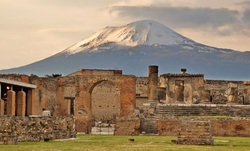 In the afternoon, we visited the ancient Roman town of Pompeii, which in 79AD was covered in 20 feet of ash over a four-day period following the eruption of Mount Vesuvius. Some of the 20,000 residents of Pompeii were able to escape, but most of them were buried in ash, as were all the buildings. When archaeologists began excavating the site in the 1800s, they discovered an ancient Roman city that was relatively intact. The layers of volcanic debris protected many of Pompeii's buildings, which included a traditional Roman forum, public baths (with a sophisticated system of indoor plumbing), an enormous amphitheater, beautifully crafted homes, and numerous temples--including the Temple of Isis, where Jhan and I got a bit distracted and became temporarily separated from the rest of our group. We eventually met up inside the amphitheater, where we watched the group come in through the tunnel that had once been the entryway of the Roman gladiators.  We spent Friday night in the modern city of Pompeii, which is relatively small yet bustling. The next morning, our first stop was a tour of a buffalo mozzarella factory. Like India, Italy has indigenous breeds of water buffalo. These amazingly docile and personable creatures are considered the source of the sweetest, creamiest mozzarella that Italy has to offer. The site we visited included both a factory and a farm, with hundreds of young and adult buffalo. Jhan and I made it a point to connect with every buffalo that would welcome us, which was the vast majority. While eating their morning hay, they would stop to let us rub, scratch, and caress their heads and necks. Some of them walked clear across the paddock to get our attention. We fell in love with these wise and wonderful animals, and it was hard to pull away. After sampling more cheese than we have ever been accustomed to eating in one sitting, we re-boarded the bus and traveled to the ancient beach community of Paestum. 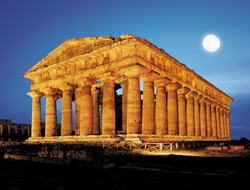 First settled by Greeks in the 6th Century BC, Paestum is the home of three ancient Greek temples that are considered among the largest and most intact of these structures in the entire world. One of these temples is to Athena, and the other two are believed to be to Hera and Poseidon (although their origin remains a mystery). Before visiting the temples, we stopped in the local archaeological museum, which displays many of the artifacts found in and around the site. Two of the most interesting finds, at least for me, were a container of 2000-year-old honey and the tomb of an individual believed to be a shaman or seer. On the lid of the tomb is a carving of a figure that appears other-worldly. 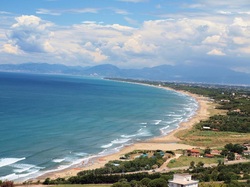 The temples themselves are breathtakingly beautiful and enormous in size. They are evidence of the extraordinary ability of ancient Greek architects, engineers, and builders. Every detail of these temples was meticulously designed using sophisticated mathematical principles. We were so taken by the temples that we had not noticed the setting, which was one of the loveliest stretches of sandy beaches in all of Italy. That evening, Jhan and I had a chance to take a long walk on the beach, where we witnessed the intense splendor of a flaming red sunset. We were joined by our friend Lori, who shared with us her way of honoring dead loved ones by writing their names in the sand and then waiting for the waves to wash them away.  On Sunday, we began our return trip northward, stopping in the provincial capital of Caserta to take in the royal palace there. Built in the 18th Century for the Bourbon kings of Naples and Sicily, the palace itself consists of 1200 elaborately-decorated rooms. Inside the palace, we viewed an exhibit by a French photographer named Robert Doisneau. Being completely unfamiliar with his work, Jhan and I were surprised and delighted by the exhibit, which captures various aspects of Parisian life in the mid 20th Century. Some of Doisneau's photographs made us laugh out loud, whereas others were touching and poignant. Ironically, we were not brought to Caserta to see the inside of the palace or even the photo exhibit. What makes this site world renown is the gardens in back, which extend for over two miles and include extensive reflecting pools filled with fish and flowing into spectacular waterfalls.  The gardens themselves are almost too vast to be seen on foot. We decided to rent bikes to climb up to the top of the hill, which is the site of a major waterfall and also of an area that the local people refer to as an "English garden." This garden is actually an enormous arboretum containing trees from around the world, including fir, redwoods, oak, palms, and hundreds of other species. At the center of the arboretum is a large pond surrounded by structures designed to resemble ancient Greek ruins. Although we had a picnic lunch on the grounds, our preference might have been to just camp there for a few nights. As with all of the sites we visited on this field trip, the palace at Caserta is worthy not of a few hours but of days, weeks, or even months of exploration. The more we get to know Italy, the more we are in awe of its magnificent beauty. Compared to the US, there is little wilderness. But what we have seen is the spectacular ways that people have found to co-exist and co-create with nature. Sustainability is not just an abstract notion here, but rather a way of life that has been practiced for thousands of years. Needless to say, this place has inspired us in some unexpected ways. Our mantra for this trip has been, "Thank You. More Please." (Some of you may know the film reference). We are extremely grateful for all the unique people and places we have encountered thus far, but we also suspect that there are some wonderful new surprises to amaze and inspire us--just around the corner. We're delighted to receive all of the insights and gifts from this journey and take them back to share with our loved ones in Tucson, Omaha, Seattle, and beyond.
0 Comments
 This past weekend, Jhan and I had the privilege to travel to Assisi, along with our friend Lori (who is both a regular Global Chant member in Tucson and also one of my students here in Orvieto). We arrived on a Friday afternoon after a two-hour train ride from Orvieto. Once we got settled in, I was drawn like a magnet into the Basilica of Saint Francis, which is visible in the foreground of the picture on the right. The basilica has three levels and is breathtakingly beautiful, but what makes it most special--in my eyes, at least--is the crypt where St. Francis' remains are entombed. These are found on the lowest level of the basilica, which is also the humblest and least ornate. 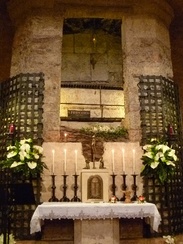 The crypt itself is a concrete pillar with a simple altar on one side. Ten years ago, I spent three days sitting in meditation there. It was one of the most important experiences of my life, and returning there was no less profound. It felt like a homecoming for me and a chance to reconnect with the beautiful, joyous energy of my beloved San Francesco. Although I always feel his presence with me, there is something extraordinary about being in physical proximity to his remains. It's like getting a recharge from the most powerful spiritual battery one can imagine. In the evening, we stayed in the basilica until it closed. As we were leaving, we encountered a vespers service on the main floor, with some of the most beautiful, heartfelt chanting I have ever heard outside of Global Chant. Dear fellow chanters, I know you were there with us in spirit. 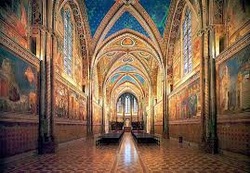 We were privileged to attend special services of various types held for the local people at the beginning and end of each day. These generally took place on the main floor of the basilica, shown here., although we also took part in mass and vespers in the tomb area. At one point, Jhan, Lori and I had the tomb area to ourselves, sitting in perfect silence in this magnificent place. If this had been the extent of our time in Assisi, we would have been more than satisfied. But we were extremely blessed to experience much more.  On Saturday, we walked down to San Damiano. This is the small ancient sanctuary that San Francesco and his tiny group of monks rebuilt themselves after he received his famous vision (more about that in a moment). The sanctuary itself, which had been in shambles when San Francesco began repairing it, is intimate, perfectly preserved, and extremely peaceful. Surrounded by gardens and other buildings, it eventually became the living space for St. Claire and her order of nuns. The site where St. Claire died is marked by a small sign in the dormitory room that sits just above the sanctuary.  Later that afternoon, we visited the Basilica of St. Claire, which is right above San Damiano within the walls of the ancient city. As legend has it, San Francesco heard Jesus speak to him while he was praying to a cross that hung at San Damiano. Jesus said, "Go and repair my house, which as you can see is falling into ruins." At first, San Francesco interpreted this message literally, which led to his reconstruction of San Damiano, but eventually he came to understand its broader significance. The reason this story is pertinent here is that the Basilica of St. Claire holds the very icon to which San Francesco was praying at the time he had his vision. Seeing this icon was inspiring to us for a number of reasons, not the least of which is the fact that it has survived so perfectly intact for 800 years. But also, we received our own personal messages from it as we sat in the church. I will share much more about this at a later time.  The last stop of our pilgrimage was the church of Santa Maria degli Angeli, which is where San Francesco resided during the final years of his life and is also the site of his death. As you can see from the photograph, there is a small simple structure within the expansive sanctuary. This structure, known as the Porziuncola, is another tiny church that San Francesco rebuilt and that also served as his primary place of worship for many years. As with most of the churches in Assisi, this one closes for lunch, and because we had a train to catch back to Orvieto, we had only a limited amount of time here. But Jhan and I agreed that this sacred site alone merits another visit to Assisi. We do not yet know when that will happen, but it could be soon. The Feast of Saint Francis is Oct 4, and this year Pope Francis will be in Assisi to celebrate San Francesco's birthday. We know that the city will be receiving millions of pilgrims from around the world on that date, and we do not plan on being among them. But perhaps just before that date, we will return to Assisi for another spiritual retreat there. 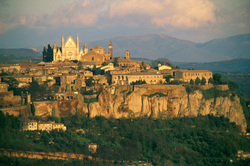 Three weeks ago today, Jhan and I left for Italy, where I am teaching three courses through the UA study abroad program. Our home base is the ancient walled city of Orvieto, which sits on top of 500-foot cliffs in southern Umbria. Orvieto is one of the most breathtakingly beautiful places I have ever seen, with 360-degree views of the surrounding towns, farms, and hills. Everywhere you turn, there is a spectacular view to be had. The farmland below Orvieto includes vineyards and olive orchards. We have seen pears, figs, and peaches growing alongside the road on our many walks in Orvieto. 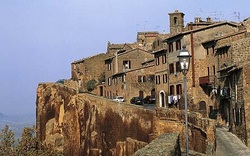 The city, which has a population of about 6000, has really charmed us with its cobblestone streets and beautiful stone buildings. We've tried to walk down every little street and alleyway in the city, exploring Orvieto to the last detail. Almost every day, we make a discovery--caves and wells, parks, sculptures, little shops that cater to the locals, hanging flower pots on medieval buildings, arched doorways, lush courtyards, tiny piazzas that are hardly bigger than a driveway, flocks of swallows flying over the cliffs at sunset, hazelnut and walnut trees dropping their fruit onto streets and walkways. 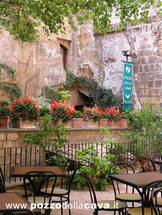 One of our favorite places in Orvieto is Pozzo della Cava, an ancient Etruscan cave that was converted into a well during medieval times and that is now one of the city's major attractions. Pozzo features a sunken terrace that has become my unofficial classroom. Fortunately, the family that runs the place has made us all feel very welcome. They bring my students food and drinks as we discuss course material, take time to show us some of the unique features of the place, and have introduced us to a few of the local delicacies. Jhan and I have sat with the regulars at the cafe and held conversations using our limited (but improving) Italian. The local folks we have met there have been very welcoming and have given us a unique perspective on life in Orvieto, Italian politics, food, culture, and religion.  The local organizers of the study abroad program in Orvieto have been extremely warm and generous to us. They were able to locate a guitar that we will be using when we start the Orvieto chapter of Global Chant, which could happen as early as next week. One of my students has actually been a GC regular in Tucson, which means that we are assured that at least three people will show up to chant when we meet for the first time. That was the size of our Tucson circle back in 2001. So, we know that we have enough people to get the ball rolling here. Even though we have not had an official circle here, Jhan and I chant at home, and we keep all of our GC family in our hearts and intentions as we do. We are eagerly awaiting the next time all of us are together again. In the meantime, I will continue to update you on life here in Orvieto. It took us a while to get a regular Internet connection established, but now that we have it, I will do my best to let you know how things are going for us. We always welcome hearing your news, if you would like to drop either of us a line. In Love & Joy, |
I want to hear from you! Please share your questions and comments. And sign up for my newsletter, where I will pass along the insights, ideas, and inspiration that come my way.
Contact me:Archives
November 2023
|

 RSS Feed
RSS Feed
